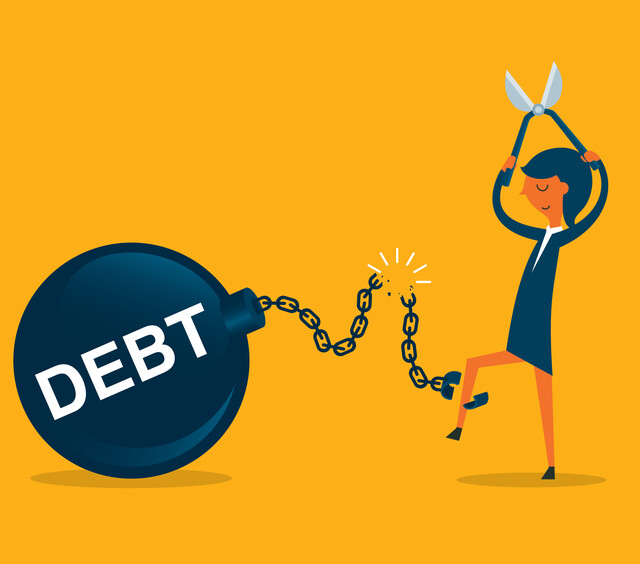Key Definitions
1. Payday loan � This is a small amount of cash lent on the agreement that it will be paid off when the borrower gets his/her next salary and usually at a very high rate of interest.
2. Rock bottom � This is the worst possible financial level. It's commonly called bankruptcy.
3. Cash advance � This is a service offered by credit card companies. It allows the user to withdraw cash over the counter or through ATM up to a certain amount.
Introduction to Debt Spiral
A debt spiral is a cycle that a lot of people get into. When one is in it, everything seems to be spinning out of control. It feels more like an aircraft that has gone into a tailspin � nothing can pull it out until it crashes, and this is true for people trapped in a debt spirals. Most of the time, they end up hitting the rock bottom.
The debt spiral starts quite innocently. Often, it starts with a simple financial mistake such credit card mismanagement. The following is a hypothetical example;
If you get a credit card but you don't know how to use it properly, you might start buying things you would not buy with cash because you feel that the credit card gives you the power to buy more items. You get the illusion that a credit card is your money, when in fact, it is borrowed money; money you do not owe. This is where you begin to fall into a debt spiral.
Soon, you will apply for another card, maybe two or three, and swear you will use them wisely. Unfortunately, you won't and the amount of your income that goes towards servicing your credit card debt will keep on growing and before you realize it, as if all in one day, your credit card debts have spun out of control.
At the same time, you might have an auto loan and a mortgage on your finances. So, the total burden of debt will begin to get too difficult, and you will start to use your credit card to repay them off. Sound like a great financial strategy? Wrong. Doing so only increases your portion of the more expensive credit card debt, in a futile attempt to show you are repaying your often cheaper debts � credit card debts are often the most expensive.
A bigger disadvantage is that when you use your card to repay these types of bills, the payment is interpreted as a cash advance. A credit card cash advance attracts a higher interest, which means you are getting deeper into debts. Sooner than later, you will begin to pay off your card using another card, and at this point you will note you are having money problems � unless you have way too many cards.
As the total debt rises, a large and increasing portion of your income will go towards paying off your debt, leaving inadequate amount for you to spend on bills and food. Therefore, you will start taking out payday loans to meet your regular bills. This is a loan that you should avoid when you are in a debt spiral. It is like adding fuel to fire, the fastest way to get to the rock bottom.
Often, event will unfold as follows: You will get a payday loan of $200, and agree to repay $240 (a very low interest for a payday loan) in three weeks. Three weeks will pass by, and you won't have all the cash you require to repay the loan, thus you will get another $240 payday loan to repay the previous $240 loan, but now you owe $ 280 in three weeks�
Already, you are in a debt spiral!
Not sure whether you are financially health or not? Compare and calculate your expenditure with the following guidelines given by the financial community.
|
Compare your expenditure to the guidelines of the financial community Housing 35% Rent or mortgage, repairs, taxes, insurance, utilities and improvements. Transport 20% Public transportation, parking, insurance, repairs, gas, oil and monthly payments. Debt 5% Personal loans, credit cards, student loans as well as other debt payments. Savings and Investments 20% Bonds, stocks, savings accounts, cash reserves and retirement funds among others. Other expenses 20% Insurance, food, dentist and doctor bills, clothing, prescriptions and personal. |
When calculating your recommended expenditure in every category, multiply your gross income by the recommended percentages. For instance, if you have a gross income of $3,000.00 and the financial community recommendation for housing allowance is 35% multiply your gross income, $3,000.00 by that percentage, 35%. The recommended monthly expenditure for housing should not be more than $1,050.00.
To calculate your true budget expenditure for each month in every category, divide monthly expenditure by gross income then multiply by 100. For instance, if you have a housing expense of $1,200.00, divide this by $3,000.00 then multiply it by 100. The answer means you expenditure for housing is 40% of the financial community's recommendation.
Use the Table Below to Evaluate Where You Are Going Wrong
|
Budgeted Expense |
Recommended |
Recommended Expenditure (Recommended % x gross income) |
Actual Expenditure |
Budget % (expense/income)x 100 |
Explanation |
|
Housing |
35% |
$ |
$ |
% |
|
|
Transport |
20% |
$ |
$ |
% |
|
|
Debt payments |
5% |
$ |
$ |
% |
|
|
Savings |
20% |
$ |
$ |
% |
|
|
All others |
20% |
$ |
$ |
% |
Types of Borrowers and the Likelihood of Getting into a Debt Spiral
There are three distinctive borrower typologies � reluctant borrowers, lifestyle borrowers, and survival borrowers. These types are not static and people can move between these classes due to external influences on behavior and attitudes.
1. Survival Borrowers
They borrow to add-on their earning for day-to-day expenditures. This class tends to have very low income and is highly likely to experience a debt spiral. Survival borrowers are often comfortable using catalog credit, rent to own, home credit, and payday loans.
-
Catalog � used for white goods and clothing.
-
Rent to own � used to buy white goods.
-
Home credit � seen as non-judgmental, flexible, and friendly.
-
Payday loan � used by employed people.
They focus on the affordability of payments, which are often low weekly amounts.
2. Lifestyle Borrowers
They use credit for a single purchase. They often have many small loans and they are likely to have experienced a reduction in income. They usually feel comfortable with store cards, online credit, catalog, and home credit.
-
Catalog � seen as having little pressure to pay.
-
Home credit � seen as flexible, convenient, and friendly.
-
Online credit � attractive because of small repayments.
-
Store cards � used if provided by retailers.
Just like survival borrowers, lifestyle borrowers are not likely to use mainstream loans such as bank loans, mortgages, overdraft or credit card because they think that they cannot qualify due to their low credit scores.
3. Reluctant Borrowers
These are individuals who have seen their earnings fall and find it hard to manage the credit they borrowed when they had more income. They often borrow mainstream loans such as bank loans, and mortgages.
-
Mortgages � taken when income was high.
-
Bank loans � taken when income was high and now trying to repay them.
-
Credit card � although still with them, they are less used.
This group of borrowers has the highest chance of getting into a debt trap.
Debt Spiral Warning Signs
There are some obvious warnings signs you might have a debt issue � Constantly watching for these signs will keep you from getting into the debt trap.
1. Making Only the Minimum Payment
Repaying the minimum payment is a bad trend that will eventually lead you into a debt spiral. If you are carrying a huge balance on your card, it might take years to repay and cost hundreds in interest. It is even worse if you are using once credit card to repay another. It is a clear sign you are heading to the rock bottom.
2. Impulse Buying
People are different � some enjoy window shopping while others enjoy purchasing everything they see. Credit cards are good, but you should only use them if you can repay them in full at the end of the grace period. If you are shocked at the amount you spend at the end of this period, there is a high chance you are an impulse spender and heading into a debt spiral.
3. Late Payments
The simplest way to destroy your credit scores is to pay your bills late. If you find yourself always paying your debts late, find out the root cause of this habit. If it's because you forget a lot, set up a preauthorized checking to avoid costly penalties and fees. If you do not have the cash to repay, you might be having a spending problem.
4. Maxing Out Your Credit Card
Your credit card comes with a relatively high limit so that you can buy occasional expensive buy, but not to drown yourself into unwise loans. You will get in trouble if you assume that your credit limit is your spending limit. This type of thinking is risky. Maxing out your credit card every month, followed by paying the minimum repayment leads to a financial disaster.
5. Taking Cash Advances
Cash advances are usually expensive. Actually, some advances attract interest rates of up to 30%. If you find yourself depending on cash advances, rethink your finances.
6. Squabbling About Debts
According to a research done by students from Florida International University, you are showing signs of financial stress if you find yourself arguing with your partner about your monthly bills. Fix this problem through cooperation and communication.
7. Unknown Total
The Consumer Credit of America argues that losing track of your debt is a clear sign of brewing trouble. Always know the amount you owe at the end of every month.
8. Withdrawing Retirement Funds
You will be heading in the wrong direction if you withdraw cash from your retirement or savings accounts. Using your savings to pay bills or expenses is a clear sign that you need to cut your spending and live within your means.
How to Get Out of Debt Spiral without Declaring Bankruptcy
Barbara Steinmetz, a financial organizer in San Mateo, Calif, says that when people do not have emergency funds, credit may be their only safety net. Additionally, Gail Cunningham, a member of the National Foundation for Credit Counseling, argues that if personal finances are out of whack due to one reason or another, people have three main options: earn more, spend less, or do both.
This is the general advice given to people looking to get out of debt, but if you looked at the hypothetical example we gave at the beginning of this article or you have ever tried to untangle the debt spiral, then you know that there is a little more to it than basic advice.
Here is how you can avoid a debt spiral (steps of avoiding debt spiral):
1. Assess the Damage
Take the count of all the money you owe, at what rates, and to whom. Many individuals with high amounts of debt shift the burden from one person to the next without knowing the exert amount.
Steinmetz says that without the numbers, it is very easy to convince yourself you are yet to get into a debt spiral. She recommends putting all your debts on a table, including car loans, credit cards, mortgage and even student loans. Then, compute the following:
-
The amount you owe on credit cards as well as other consumer loans.
-
The amount you spend every year on interest.
-
The amount of your income that goes toward repaying debts.
2. Find the Root Cause
Before borrowing more credit to pay your current high-interest loans or even withdrawing from your saving and retirement account, be honest about what habits or circumstances got you into the debt spiral.
Cunningham argues that people often put all types of fixes but they fail to probe the root of their financial problems. Ensure that you track all your expenses to identify areas you can save a few dollars and/or avoid the entire expenses. Tracking your money also helps you to realize exactly where you went and/or are going wrong with your money. Use a worksheet similar to what is given below.
|
Date |
Expenses |
Amount: Check, Debit, Cash |
Credit Amount |
3. Make It a Team Effort
According to Cunningham, the result will be greater if it is a joint effort. For instance, call a family meeting and agree on where to reduce your expenses.
Here are some reductions to consider:
1. Move to a smaller home � Nobody has ever died because of sharing a room with a sibling.
2. Relocating to a smaller town � Consider shifting to a smaller municipality if it is cheaper travelling to your job.
3. Get rid of the latest car model � Sell that luxurious, high fuel consuming car and find a decent used car and buy with cash.
4. Cut back to a single car or even no car � Sometimes your own two feet or public transport can offer all of your transportation needs at half the price of owning a car.
5. Stop using a credit card � This involves all form of lending systems that needs you to pay interest. If anything, you don't want to accumulate more debt.
6. Stop eating out � Limit eating out to once per month or during special occasions. Dining out is at least four times as expensive as preparing a meal at home and less healthy.
4. Paying Off Debt
There are three main methods that you can use to repay your debts: the Debt Snowball, the Debt Avalanche, and the Debt Spiral.
The first two methods argue that you should pay the minimum or least payment on all your debts apart from one, focus all additional payments on this debt until it is repaid in full, then focus on another, and move on until you are debt free.
However, Debt Snowball and the Debt Avalanche vary when it comes to the order in which they suggest you pay the debts. You will end up paying less interest if you use the Debt Avalanche method because you pay the debt with the highest interests first.
For instance, assume you have the following debts:
A. A credit card loan of $2,500 at 8.5 percent
B. A home loan of $10,000 at 3 percent
C. A student loan of $8,000 at 6 percent
D. Another student loan of $7,000 at 5.2 percent
E. A car loan of $18,000 at 5.5 percent
Using the Avalanche method, you would pay A, C, E, D, and then B in that order. However, it is hard to experience the wins unless you are highly motivated. Therefore, you might end up paying more interest if you do not remain motivated and committed to your goals.
With the Debt Snowball method, the wins come easily. Here, you would pay your debts in the following order: A, D, C, B, and then E.
However, it does not make sense to pay the least-balance debt or the highest-interest debt first. What if you used both the debt balances and interest rates to repay your loans? Simply divide the debt balances by their interests and then order the results from the smallest to the largest. Here, you would repay your debts in this following order: A, C, D, E, and then B.
This is referred to as the Debt Spiral method and has both the benefit of the Debt Snowball method, that is, it spread out the wins quickly, and the Debt Avalanche method, that is, it reduces the total interest you pay.
More on Getting Out of the Debt Spiral
Debt Consolidation
One of the best ways to get out of the debt spiral is debt consolidation. This allows you to take all your debts, which might be several bills and payments, then combine them into one payment. After this, you will be making one payment every month to repay all the debts off. Debt consolidation is a crucial weapon for anyone in a debt spiral. It enables you to start bringing things back in order.
Seeking help from a debt counselor
Another way of getting out of your debt spiral is getting help from a debt counselor. A debt counselor is a trained person who knows how to deal with debt that is out of control. Usually, they are highly successful at doing it.
It is important to take the necessary steps whenever you realize you have a debt issue. For best results, ensure you have a budget, keep track of your expenses and ensure that your income is greater than your expenses.

























